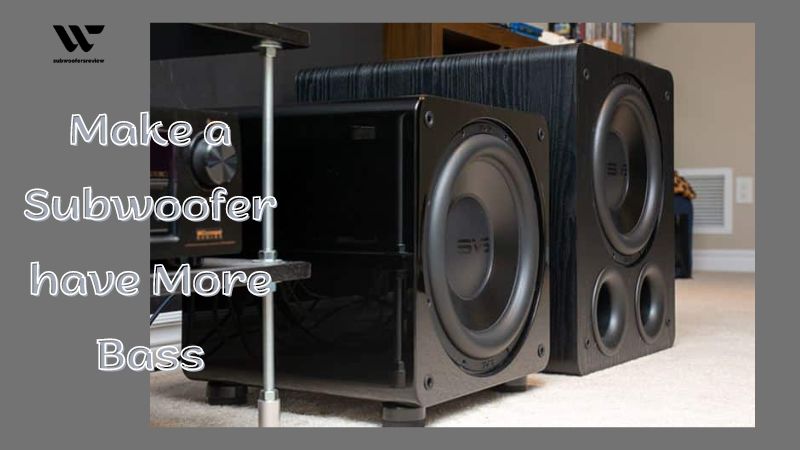Welcome to our latest blog post where we explore the fascinating world of sound and delve into the realm of subwoofers. If you’re someone who loves music and wants to enhance your audio experience, this deep dive is for you. Today, we’ll be diving into the topic of how to make a subwoofer have more bass, uncovering tips and techniques that will take your audio setup to the next level. So, without further ado, let’s embark on this sonic adventure and unravel the secrets behind achieving that deeper, richer bass you’ve been craving.
How to Make a Subwoofer have More Bass
Determine the right type of cover
We need to know your cabinet type before modifying the subwoofer to produce extra low frequencies. Your subwoofer’s cabinet type will have a major impact on how much bass it can create. As was already said, the kind of subwoofer box can make a significant difference.
Sealing enclosures, vented enclosures, and vented enclosures are the three primary varieties of enclosures. When deciding which subwoofer to use, weigh the benefits and drawbacks of each option. Here are some things to think about:
The most typical style of sealed box used in subwoofers produces tight, powerful bass and is easy to create. It is also relatively modest in size. Nevertheless, sealed enclosures are frequently less effective than other types, so picking the appropriate size for your subwoofer is crucial.
The sealed case is less noticeable than the vented case, which makes use of openings or vents to improve performance. In comparison to closed enclosures, this style also provides deeper bass. To produce big bass, though, additional power is also needed.
A band-pass enclosure uses two chambers to maximize efficiency and create deep, prolonged bass. It combines a sealed and vented enclosure. Although difficult to correctly build and maybe requiring professional subwoofer installers, these are quite effective.

Place your subwoofer properly
The subwoofer’s output of sound can be simply increased by changing its position. So you might need to adjust the woofer to the suggested position if you want to get the best audio experience. The subwoofer is typically installed in a home’s corner. But in other circumstances, that might not be the best option. The subwoofer will produce the loudest bass if it is placed in the room’s corner. However, not everyone experiences the bass production because of the placement.
Some people have diminished hearing. The easiest place to get 6 decibels of bass without an amplifier is in the corners, though. Place it in the middle of the room for even bass so that everyone can hear the same sound. Such placements even provide a bass response, which results in music that spreads uniformly throughout the entire room.
Try to position the subwoofer at least 3 inches away from the wall if your house is small. It is advised for the tailgate subwoofer to be placed there. If the room is not square or rectangle-shaped, try placing the subwoofer in an asymmetrical position. This will still produce the most bass in such spaces.
Adjust the subwoofer properly
Another wonderful approach to get increased bass effects is by tuning the subwoofer. The distinctive “Boom effect” of subwoofers is well known. However, you must adjust the woofer for a louder and cleaner output sound. To ensure that the subwoofer is adjusted properly and doesn’t overpower the device, you might need to modify its parameters.
There are various sound adjusting buttons on a subwoofer. You may spin certain keys on the majority of models to enhance the bass. Turn off bass boost if it’s present and activate the low-pass filter at its maximum setting on the amplifier. Set the level control to 0 as well.
Your music can now be played at a quarter or low volume. The amplifier’s volume control should be adjusted such that there is no distortion and the sound is louder than the other speakers. Return to the low-pass filter and gradually lower it until the highs and mids are eliminated. Turn your attention to the bass booster and make a few minor adjustments to get the sound volume you like.

Using resonant rubber on the Sub-Box
Because your box has “springs” from the use of resonant rubber, it may move and vibrate more strongly with each beat. The energy that the rubber fibers hold during stretching and compression is subsequently released in concert with the bass, enhancing both tone and volume. The resonant rubber aids in lowering noise and distorted sound in addition to enhancing strength and clarity.
Any extra vibrations are absorbed and dissipated by the rubber when it is applied to the internal walls of your box, preventing them from degrading the quality. The overall sound quality improves and a more consistent experience is ensured. Because it is simple and inexpensive to use resonant rubber, it is the best option for people who wish to maximize the use of their spare box without spending a fortune.
Final Thoughts
In conclusion, by following the steps outlined in this guide, you can enhance the bass performance of your subwoofer. From selecting the right enclosure and amplifier to optimizing placement and adjusting settings, each aspect plays a crucial role in achieving a deeper and more impactful bass response.
Remember to experiment and fine-tune your setup to personal preferences and room acoustics. With a little patience and attention to detail, you can enjoy a truly immersive audio experience with a subwoofer that delivers rich, powerful bass. So go ahead, explore the depths of sound and elevate your music and movie-watching experience to new heights.

